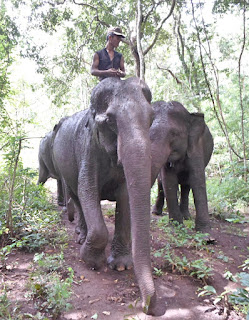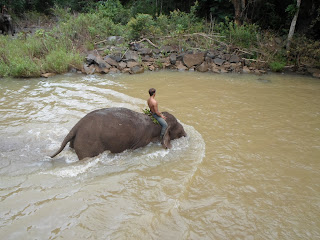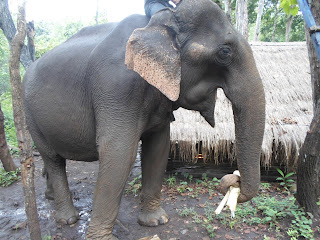After the brief visit to Pulong Village, we picked up a few banana tree stumps and headed out to see a few Asian elephants in the forest. I wasn't sure where we were dropped off, but the trek down from the road to the river was steep and somewhat challenging considering that each of us had to carry a banana tree stump, which I imagined to weigh between 2-4 KG each. When we arrived at the bamboo hut near the river, we set down our stuff and went to see the Pulong waterfall and river. It was pretty. Then at around 12 PM or so, Heng introduced us to some elephant "rules" and etiquette before we went in search of the elephants.
The 3 female Asian elephants we saw were: Chi Wat (92-years-old), Chi Chering (65-years-old), and My Koon (57-years-old). Chi Wat used to work for the Khmer Rouge by carrying land mines, logs, and rice, among other things. Unlike many elephants in that period, she survived the land mines. Each of these three elephants has a distinct personality. For example, My Koon is known to be the greedy eater and Chi Wat the queen (rightfully so in my opinion). They are also known to be temperamental with tourists. On a good day, they may allow you to get close and touch them, but on a bad day, they may whack their trunk or charge at you.
When the elephants appeared, I was petrified for their sheer size even though they had a mahout rider each. These domesticated elephants have the power to hurt if they so will. I was out of my comfort zone and being in such close proximity to them put me off balance for a bit. I was standing right in front of Chi Wat, the oldest, when she approached me for the bananas I was holding. Instinctively, I stepped to her left to feed her a banana at a time. As she was the fussy one, she preferred to be fed directly to her mouth, not her trunk. It grossed me out to put a banana in Chi Wat's slimy tongue. She was also covered in mud, so I was being a little prissy and afraid of getting mud on myself. When I ran out of bananas, I had a mild panic attack as I thought she was going to whack her trunk at me. I fled and watched her from a distance. By that time, I was done with feeding bananas to the elephants and remained content at just watching them from a few feet away. Slowly, I warmed up to the elephants and mustered enough courage to touch them. Their grey skin felt like sandpaper, and they have deep creases and folds in some parts of their skin, including thick black hairs.
When our group ran out of bananas, the elephants left and foraged for bamboos in the area. They got bored of us humans, I suppose. Soon the only female mahout in the community gave us some insights as to the history and lives of these elephants. She said that these elephants are spiritual creatures that can react to any bad deed done by the mahouts. There was a time, for example, when these 3 elephants cried persistently and refused to eat the bananas that a group of tourists had brought. The mahouts and guides were surprised and concerned. They learned later that the elephants were upset that the mahouts had killed and eaten a snake earlier. The mahouts had to make amends to the elephants (I forgot how) and all was good in the end. These mahouts, most of them male, take turns to spend a week with the elephants. Their job includes walking with, cleaning, and ensuring that the elephants don't wander off from the forest and out into the village.
The following are some interesting facts about these Asian elephants:
- Asian elephants are endangered. Only about 260 of wild elephants exist in Cambodia's forests.
- The domesticated elephants have lived with the Bunongs for centuries. Many were used to clear forests for farm lands, to carry heavy things, and for a while, to carry tourists (this practice has since been disallowed). These elephants are now retired, but through the initiative of the Green House Bar and Restaurant's Elephant Community Project, the community has found a way to earn some income by allowing tourists to see the elephants (but not ride on them). By doing so, tourists indirectly save the forests, the elephants, and the community to which they belong to.
- The Bunongs do not breed their domesticated elephants as they think it is wrong; they akin it to in-breeding. Once these aged domesticated elephants die out, the Bunongs will be left with no elephants unless they have permission from the government to catch a few wild ones in the forests.
- These Asian elephants are smaller than the African elephants (in ear flaps and height). They have 18 toe nails in total: 10 in front and 8 in the rear.
Next we headed back to the river rock area to have lunch and chill. Many of us took an afternoon siesta, and we woke up just in time to catch the 3 elephants walking to the falls for their bath. When they arrived, all of us jumped into the water to participate in cleaning them. Never before have I imagined myself to be in the same waters as the elephants and scrubbing mud off of them! It was a mind-blowing and incredible experience.
Finally, after their bath, we walked up to the hut to give the elephants their treat - the juicy banana tree stumps we so strenuously lugged down for them. The elephants chewed them contently, and it was a happy sight for all. I'm glad that the elephants behaved well and did not harm any of us. They were enormous and mystical, yet also vulnerable, gentle, and spiritual. There's no doubt these elephants were the highlight of this tour.
Next post: Putong Village, Mondulkiri, Cambodia - 12 & 13 October 2015
Previous post: Sen Monorom and Pulong Village, Mondulkiri, Cambodia - 11 & 12 October 2015









































No comments:
Post a Comment